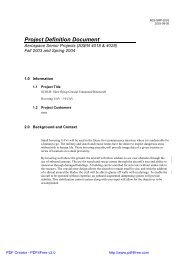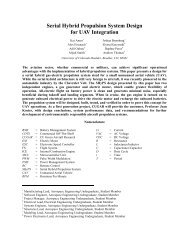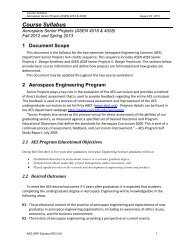PFR - Aerospace Engineering Sciences Senior Design Projects ...
PFR - Aerospace Engineering Sciences Senior Design Projects ...
PFR - Aerospace Engineering Sciences Senior Design Projects ...
You also want an ePaper? Increase the reach of your titles
YUMPU automatically turns print PDFs into web optimized ePapers that Google loves.
Project Final Report – CUDBF April 30 th , 2009<br />
ASEN 4028: <strong>Aerospace</strong> <strong>Senior</strong> <strong>Projects</strong><br />
T<br />
=<br />
2<br />
1.44* W<br />
g * ρ * S * C L<br />
* S LO<br />
Equation 13: Simplified Takeoff Distance Calculation<br />
Where W is the fully loaded weight of the aircraft (15 lbs), ρ is the density for a 5,000 ft density<br />
altitude, S is wing area, g is gravity, C L is takeoff lift coefficient, and S LO is takeoff distance. The<br />
aircraft stalls at a C L of 1.38 and an angle of attack of 12.6°. Therefore, assuming a takeoff<br />
rotation of 10°, takeoff C L was assumed to be 1.1. To account for the small drag and rolling<br />
friction assumption, a 10% margin was added to the takeoff distance. Therefore, S LO was chosen<br />
to be 90ft. With these variables, the thrust required is 6.0lb, or 3.0lb per motor. To ensure that<br />
this thrust could be met, a static thrust stand was created shown in Figure 31.<br />
Figure 31: Static Thrust Stand<br />
The thrust stand was designed so that as the motor generated thrust, it would pull against a load<br />
cell to record the static thrust. The load cell was connected to a LabView VI to record the thrust<br />
data [12] . During static thrust tests, an Eagle Tree telemetry system was used to record voltage,<br />
current, power, and motor RPM [13] . The motor set up utilized to test the thrust available was the<br />
Neu [14] 1107 2Y motor with 3300 rpm/V at 19.0 V, 40 amps, and an 8,000 ft density altitude. To<br />
make up for the extra rpm/V of the Neu 1107 motor compared to the Neu 1110 2Y motor, the<br />
voltage was lowered below that of the estimated battery pack voltage to compensate. Several<br />
different propeller sizes were tested. The amount of thrust produced by this single motor varied<br />
between 4.30 lb and 5.87 lb of thrust depending upon the propeller size and pitch. This<br />
confirmed that the amount of thrust required to make the 100ft takeoff requirement is feasible.<br />
The other major design to specification of the propulsion system is the maximum battery weight<br />
of 4 lbs. To check the feasibility of this requirement, the amount of power required to fly four<br />
laps at maximum weight was estimated. The average current draw was assumed to be 20 amps at<br />
55
















